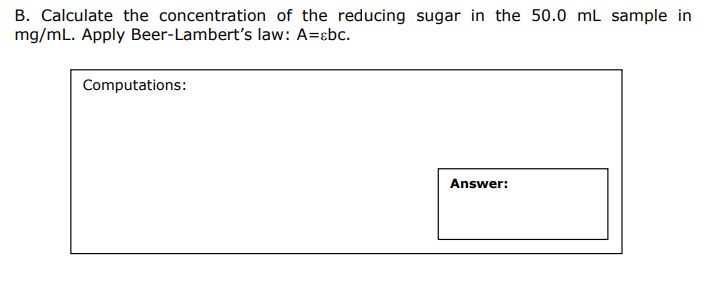A 50.0 ml juice extract is colorimetrically assayed using Nelson's test. One milliliter (1.00 mL) of the solution and the standard glucose solution (concentration: 1mg/mL) were treated with freshly prepared Nelson's reagent and arsenomolybdate reagent and then diluted to 10.0 mL separately in properly labeled test tubes. Absorbance at 480 nm for the standard is 1.702 and for the sample, 0.926.
A 50.0 ml juice extract is colorimetrically assayed using Nelson's test. One milliliter (1.00 mL) of the solution and the standard glucose solution (concentration: 1mg/mL) were treated with freshly prepared Nelson's reagent and arsenomolybdate reagent and then diluted to 10.0 mL separately in properly labeled test tubes. Absorbance at 480 nm for the standard is 1.702 and for the sample, 0.926.
Chemistry
10th Edition
ISBN:9781305957404
Author:Steven S. Zumdahl, Susan A. Zumdahl, Donald J. DeCoste
Publisher:Steven S. Zumdahl, Susan A. Zumdahl, Donald J. DeCoste
Chapter1: Chemical Foundations
Section: Chapter Questions
Problem 1RQ: Define and explain the differences between the following terms. a. law and theory b. theory and...
Related questions
Question

Transcribed Image Text:III. Problem solving. Show your computations. Answer questions briefly.
A 50.0 ml juice extract is colorimetrically assayed using Nelson's test. One
milliliter (1.00 mL) of the solution and the standard glucose solution (concentration:
1mg/mL) were treated with freshly prepared Nelson's reagent and arsenomolybdate
reagent and then diluted to 10.0 mL separately in properly labeled test tubes.
Absorbance at 480 nm for the standard is 1.702 and for the sample, 0.926.

Transcribed Image Text:B. Calculate the concentration of the reducing sugar in the 50.0 mL sample in
mg/mL. Apply Beer-Lambert's law: A=ɛbc.
Computations:
Answer:
Expert Solution
This question has been solved!
Explore an expertly crafted, step-by-step solution for a thorough understanding of key concepts.
Step by step
Solved in 2 steps with 2 images

Knowledge Booster
Learn more about
Need a deep-dive on the concept behind this application? Look no further. Learn more about this topic, chemistry and related others by exploring similar questions and additional content below.Recommended textbooks for you

Chemistry
Chemistry
ISBN:
9781305957404
Author:
Steven S. Zumdahl, Susan A. Zumdahl, Donald J. DeCoste
Publisher:
Cengage Learning

Chemistry
Chemistry
ISBN:
9781259911156
Author:
Raymond Chang Dr., Jason Overby Professor
Publisher:
McGraw-Hill Education

Principles of Instrumental Analysis
Chemistry
ISBN:
9781305577213
Author:
Douglas A. Skoog, F. James Holler, Stanley R. Crouch
Publisher:
Cengage Learning

Chemistry
Chemistry
ISBN:
9781305957404
Author:
Steven S. Zumdahl, Susan A. Zumdahl, Donald J. DeCoste
Publisher:
Cengage Learning

Chemistry
Chemistry
ISBN:
9781259911156
Author:
Raymond Chang Dr., Jason Overby Professor
Publisher:
McGraw-Hill Education

Principles of Instrumental Analysis
Chemistry
ISBN:
9781305577213
Author:
Douglas A. Skoog, F. James Holler, Stanley R. Crouch
Publisher:
Cengage Learning

Organic Chemistry
Chemistry
ISBN:
9780078021558
Author:
Janice Gorzynski Smith Dr.
Publisher:
McGraw-Hill Education

Chemistry: Principles and Reactions
Chemistry
ISBN:
9781305079373
Author:
William L. Masterton, Cecile N. Hurley
Publisher:
Cengage Learning

Elementary Principles of Chemical Processes, Bind…
Chemistry
ISBN:
9781118431221
Author:
Richard M. Felder, Ronald W. Rousseau, Lisa G. Bullard
Publisher:
WILEY